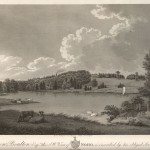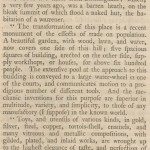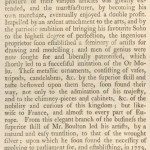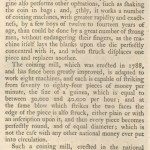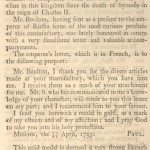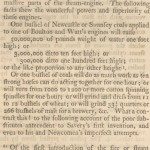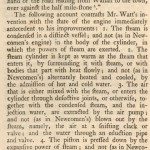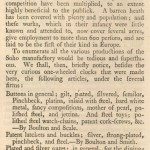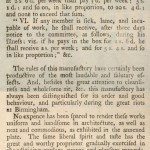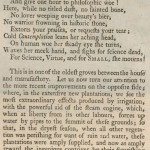Matthew Boulton’s Soho Works, Iron Foundry and House at Soho near Birmingham, 1801
Stebbing Shaw’s The History and Antiquities of Staffordshire (1798 and 1801) is a major source not only for the antiquities and topography of the county, but for its economic, social and cultural circumstance at the end of the 18th century. His history is monumental, building on the limited accounts by Erdeswicke, Chetwynd and Plot in the 17th century, but he died before it was completed.
Amongst Shaw’s correspondents were two Lunar men, Erasmus Darwin and James Keir who provided him with information about the geology and industry of Staffordshire. Shaw traveled across the county recording his own observations on agriculture, manufacturing and urban development. He visited Etruria in North Staffordshire, the site of Josiah Wedgwood’s pottery works and residence. He also went to Matthew Boulton’s factories and saw his home and grounds in the south of the county.
As early as 1768, Shaw had received a letter from Erasmus Darwin about Boulton’s achievements and he used Darwin’s excited observations in his detailed account which is reproduced below from volume II of his history. Shaw wrote about Soho House and its grounds, the Soho Works in Handsworth and the Soho Foundry in Smethwick. He described many aspects of Boulton’s industrial enterprise and imagination:
• the production of toys and other small metal goods;
• the creation of sliver-plated vases, chimney pieces and candelabra;
• mechanically produced paintings which could not be distinguished from the hand-painted item;
• the application of mechanical power using James Watt’s improvements to the steam engine;
• the manufacture of steam engines at the Smethwick Foundry;
• coin and medal production in the Soho Mint;
• copying machines;
• overseas links;
• an insurance scheme for workers.
Shaw was enthusiastic towards the Soho Works and the landscaping of the surrounding area. He noted: “No expense has been spared to render these works uniform and handsome in architecture, as well as neat and commodious…” He also drew attention to the “gardens, groves and pleasure grounds” adjoining Boulton’s factory, which “render Soho a much-admired scene of picturesque beauty.” Here “we may…enjoy the sweets of solitude and retirement, as if far distant from the busy hum of men.”
———————-
SOHO MANUFACTORY, &c.
We shall commence our account of this curious and delightful place with a letter from a learned and philosophical admirer of the works of art and science, addressed to the rev. Mr. Feilde, of Brewood, then engaged in a History of Staffordshire.
Dear Sir,
If you admit into your account of Staffordshire the wonders of art as well as those of nature, I know no curiosity in this county so worthy your attention as Mr. Boulton’s works at Soho.
On the other side I have sent you an account of his situation and manufactory; and am, dear Feilde,
Your affectionate humble servant,
August 16, 1768. E. DARWIN.
“Soho is the name of a hill in the county of Stafford, about two miles from Birmingham; which, a very few years ago, was a barren heath, on the bleak summit of which stood a naked hut, the habitation of a warrener.
“The transformation of this place is a recent monument of the effects of trade on population. A beautiful garden, with wood, lawn, and water, now covers one side of this hill; five spacious squares of building, erected on the other side, supply workshops or houses, for above six hundred people. The extensive pool at the approach to this building is conveyed to a large water-wheel in one of the courts, and communicates motion to a prodigious number of different tools. And the mechanic inventions for this purpose are superior in multitude, variety, and simplicity, to those of any manufactory (I suppose) if the known world.
“Toys, and utensils of various kinds, in gold, silver, steel, copper, tortois-shell, enamel, and many vitreous and metallic compositions, with gilded, plated and inlaid works, are wrought up to the highest elegance of taste, and perfection of execution, in this place.
“Mr. Boulton, who has established this great work, has joined taste and philosophy with manufacture and commerce; and, from the various branches of chemistry, and the numerous mechanic arts he employs, and his extensive correspondence to every corner of the world, is furnished with the highest entertainment as well as the most lucrative employment.”
About the year 1745 Mr. Boulton, then of Birmingham, invented, and afterwards brought to great perfection, the inlaid steel buckles, buttons, watch-chains, &c, which Dr. Johnson mentions in one of his papers in the World, as becoming fashionable in this country; whilst they were re-purchased from France, under the idea of their being the production of that kingdom.
In the year 1757, John Wyrley, of Hamstead, esq, lord of the manor of Handsworth, granted a lease to Messrs. Edward Ruston and Eaves, of these tracts of common; viz. Handsworth heath, Moneybank hill, Crabtree bank, Warrens, for 99 years, with certain inclosed lands, with liberty to make some additions to the same, and to make a cut for the turning of Hockley brook, to make a pool, with powers to build a water mill. In consequence of which a small house and feeble mill were erected, for the purpose of rolling metal. On Lady-day 1762, Mr. Boulton purchased the aforesaid lease, with all the premises and appurtenances, to apply the same to such branches of the manufactory established at Birmingham as would tend to diminish expence and labour.
In order to procure his designs and improvements, &c. he soon after enlarged and rebuilt these premises, and then transplanted the whole of his manufactory from Birmingham to Soho; and though he had made very considerable additions to these buildings, he found them not sufficient for his great designs: he therefore, in 1764, laid the foundation of the present superb manufactory, which was finished in the following year, at the expence of 9000 l. From that period he began to turn his attention to the different branches of manufactory; and, in conjunction with Mr. Fothergill, then his partner, established a mercantile correspondence throughout Europe; by which means the produce of their various articles was greatly extended, and the manufacturer, by becoming is own merchant, eventually enjoyed a double profit. Impelled by an ardent attachment to the arts, and by the patriotic ambition of bringing his favourite Soho to the highest degree of perfection, the ingenious proprietor soon established a seminary of artists for drawing and modelling; and men of genius were now sought for and liberally patronised, which shortly led to a successful imitation of the Or Molu. These metallic ornaments, consisting of vases, tripods, candelabras, &c. by the superior skill and taste bestowed upon them here, soon found their way, not only to the admiration of his majesty, and to the chimney-piece and cabinets, &c. of the nobility and curious of this kingdom; but likewise to France, and almost to every part of Europe. From this elegant branch of the business the superior skill of Mr. Boulton led his artists by a natural and easy transition, to that of the wrought silver; upon which he soon found the necessity of applying to parliament for, and establishing, in 1773, an assay office at Birmingham. About this time that ingenious art of copying pictures in oil colours, by a mechanical process, was invented at Soho; and, under the patronage of the above proprietor, was brought to such a degree of perfection as to be taken for originals by the most experienced connoisseurs. This extraordinary piece of art was principally conducted by the ingenious Mr. F. Eginton, which led him to that of painting upon glass, now carried on at his neighbouring manufactory, as hereafter separately described.
Mr. Boulton finding from experience that the stream of water which had induced him to build a mill and transplant his manufactory to Soho, was insufficient for its purpose, he applied horses, in conjunction with his water-mill; but finding that both troublesome, irregular, and expensive, in 1767 he made a steam-engine, on Savery’s plan, with the intention of returning, and raising his water about 24 feet high; but this proving unsatisfactory to him, he soon after formed an acquaintance with his present partner and friend, Mr. James Watt of Glasgow, who in 1765 had invented several valuable improvements upon the steam-engine, which in fact made it a new machine. For these improvements Mr. Watt had obtained a patent in January 1769, and afterwards came to settle at Soho, where in that year, he erected one of his improved engines, which he had brought from Scotland; and, after full proof of its utility, obtained from parliament in 1775 a prolongation of the term of his patent for 25 years from that date. He then entered into partnership with Mr. Boulton, and established a very extensive manufactory of these engines at Soho, whence most of the great mines and manufactories of England are supplied, they being now applied to almost every mechanical purpose where great power is requisite.
The application of this improved steam-engine at Soho to raise and return the water, extended the powers of the water-mill; which induced Mr. Boulton to rebuild it a second time upon a much larger scale, and several engines were afterwards erected at Soho for other purposes, by which the manufactory was greatly extended, the source of mechanical power being thus unlimited.
Amongst the various applications of the steam-engine, that of coining seems to be of considerable importance, as by its powers all the operations are concentered on the same spot; such as rolling the cakes of copper hot into sheets; 2dly, fine rolling the same cold in steel polished rollers; 3dly, cutting out blank pieces of coin, which is done with greater ease and rapidity by girls than could possibly be done by strong men; 4thly, the steam-engine also performs other operations, such as shaking the coin in bags; and 5thly, it works a number of coining machines, with greater rapidity and exactness, by a few boys of twelve to fourteen years of age, than could be done by a great number of strong men, without endangering their fingers, as the machine itself lays the blanks upon the die perfectly concentral with it, and when struck displaces one piece and replaces another.
The coining mill, which was erected in 1788, and has since been greatly improved, is adapted to work eight machines, and each is capable of striking from seventy to eighty-four pieces of money per minute, the size of a guinea, which is equal to between 30,000 and 40,000 per hour; and at the same blow which strikes the two faces the edge of the piece is also struck, either plain or with as inscription upon it, and thus every piece becomes perfectly round, and of equal diameter; which is not the case with any other national money ever put into circulation.
Such a coining mill, erected in the national mint, would, in cases of emergency, be able to coin all the bullion in the Bank of England at a short notice, without the necessity of putting dollars, or any other foreign coin into circulation; and by erecting double the number of presses a double quantity may be coined.
Dr. Darwin, in a more recent compliment paid to Soho than his letter above printed, says, after a short description of this mint, that the whole of this magnificent and expensive apparatus moves “with such superior excellence and cheapness of workmanship, as well as with works of such powerful machinery, as must totally prevent clandestine imitation, and in consequence save many lives from the hand of the executioner; a circumstance worthy the attention of a great minister. If a civic crown was given in Rome for preserving the life of one citizen, Mr. Boulton should be covered with garlands of oak.”
It is worthy observation, that the ground of the silver money coined by this machine has a much finer and blacker polish than the money coined by the common apparatus.
In consequence of Mr. Boulton’s money being perfectly round, and of equal diameter, he proposed the following coincidence between money, weights, and measures, in the copper coin, part of which he hath lately executed for the British government; viz. a 2-penny-piece to weigh 2oz. and 15 of them to measure 2 feet, when laid flat in a straight line; 1 penny-piece to weigh 1oz. and 17of them to measure 2 feet; ½ penny to weigh ½ oz. and 10 of them to measure 1 foot; a farthing to weigh ¼ oz. and 12 to measure 1 foot. This plan of coincidence was prevented from being put into execution by the sudden advance in the price of copper.
In the year 1788 Mr. Boulton struck a piece of gold, the size of a guinea, as a pattern (similar to those in copper); the letters were indented instead of in relief; and the head, and other devices (although in relief), were protected from wear by a broad flat border; and, from the perfect rotundity of the shape, &c. with the aid of a steel gage, it may with great ease and certainty, by ascertaining its specific gravity, be distinguished from any base metal. Previous to Mr. Boulton’s engagement to supply government with copper pence, in order to bring his apparatus to the greatest perfection, he exercised it in coining silver money for Siera Leona and the African Company, and copper for the East India Company and Bermudas. Various beautiful medals of our celebrated naval and other officers &c. have likewise been struck here from time to time by Mr. Boulton, for the purpose of employing and encouraging ingenious artists to revive that branch of sculpture, which had been upon the decline in this kingdom since the death of Symons in the reign of Charles II.
Mr. Boulton, having sent as a present to the emperor of Russia some of the most curious produce of this manufactory, was lately honoured in return with a very handsome letter and valuable accompanyments.
The emperor’s letter, which is in French, is to the following purport:
Mr. Boulton, I thank you for the divers articles made at your manufactory, which you have sent me. I receive them as a mark of your attachment for me. Mr. S. who has communicated to me a knowledge of your character, will remit to you this letter on my part: and I recommend him to your favour.
I send you herewith a medal in gold, as a mark of my esteem and of my affection: and I pray God to take you into his holy protection.
Moscow, the 15/16 April, 1797. PAUL.
This gold medal is deemed a very strong likeness of his imperial majesty, and is finely engraved; but, what adds most to its curiosity and value is, that the die from which it was struck was engraved by the hands of his imperial consort, who distinguished her taste and talents in her early youth by modelling some of the portraits of her majesty’s family and friends in wax, and afterward made considerable progress in engraving, both in stones and in steel.
Besides the above medal, his imperial majesty honoured Mr. Boulton with such other presents as he thought would be acceptable and useful to him, viz. a collection of Siberian minerals, and of all the modern money of Russia, in gold, silver, and copper; the Russian measures and weights; with a collection of about 200 very large, and finely engraved, bronzed copper medals of all the distinguished characters of that country, recording most of its victories and great events; also the portraits of his two sons, the present grand-duke and his brother.
IRON FOUNDRY.
In order to obtain the desired degree of perfection in the manufactory of steam-engines, Messrs. Boulton and Watt found it necessary to erect and establish an iron foundry for that purpose; and they have accordingly, in partnership with their sons (to whose “activity, genius, and judgement, it must be attributed, that this great work was begun and finished in the course of three winter months), erected at a convenient distance and contiguous to the same stream, at Smethwick, a great and compleat manufactory and foundry, into which a branch from the Birmingham canal enters; and thereby the coals, pig iron, bricks, sand, &c. are brought, and their engines, or other heavy goods, are transported in boats to every part of the kingdom, there being a wet dock within their walls for four boats to lie.
The plan of this work being well digested and settled previous to laying the first stone, the whole is thereby rendered more compleat than such works as generally arise gradually from disjointed ideas. And, from the great experience of the proprietors, they have applied the power of steam to the boring of cylinders, pumps, &c. to drilling, to turning, to blowing their melting furnaces, and whatever tends to abridge human labour, and obtain accuracy; for, by the superiority of all their tools, they are enabled to attain expedition and perfection in a higher degree than heretofore. In viewing this immense fabric, and its extensive premises, the spectator is most agreeably struck with the extraordinary regularity and neatness which pervades the whole, from the common operations of the anvil, to the working and fabricating the ponderous and massive parts of the steam-engine. The following facts shew the wonderful powers and superiority of these engines.
One bushel of Newcastle or Swansey coals applied to one of Boulton and Watt’s engines will raise
30,000,000 of pounds weight of water one foot high; or
3,000,000 ditto ten feet high; or
300,000 ditto one hundred feet high;
or the like proportion to any other height!
Or one bushel of coals will do as much work as ten strong horses can do acting together for one hour; or will turn from 1000 to 1200 or more cotton spinning spindles for one hour; or will grind and dress from 11 to 12 bushels of wheat; or will grind 33 1/3 quarters or 266 bushels of malt for a brewery, &c. What a contrast this! to the following account of the poor substitutes antecedent to Savery’s first invention, and even to his and Newcomen’s imperfect attempts.
“Of the first introduction of the fire or steam engine into the coal pits, co. Stafford.
“Towards the latter end of the last century, the demand for coals on account of the iron manufacture being very great in this part of the county (Willenhall), and most of them that lay near day, in the workman’s phrase, or to the surface of the earth, having been gotten by the means of drains, horse ginns, and other small engines, many began to be in pain left the manufacture should be removed to some other part of the kingdom, where they could be gotten at a less expence, and in greater plenty. On the 14th June, 1699, one Mr. Thomas Savery, commonly called Captain Savery, presented to the Royal Society a model and short account of an engine to raise water by fire, or rather by the steam of boiling water. This consisted of a boiler, two cylindric vessels, some valves and two beams, one to act by stamping, the other by pumping or suction. Two years after, in 1701 he published a small treatise about it, called “The Miner’s Friend,” wherein he gives a larger account, and better design, of the machine, which was to be placed within the ground or pit to be drained; and the regulator, which let the rarified air pass into the tube, or hindered it from doing so, was moved backward and forward by a man that constantly stood by and worked it. It had two boilers, a bigger two-thirds full of boiling water, and one-third full of air; and a lesser boiler to supply what water was evaporated out of the bigger by working the engine. This gentleman set one of these engines down about year….in the liberty of Wednesbury, near a place called then the Broad Waters, which is now dry land again. The engine thus erected could not be brought to perfection, as the old pond of water was very great, and the springs very many and strong that kept up the body of it; and the steam, when too strong, tore it all to pieces: so that, after much time, labour, and expence, Mr. Savery was forced to give up the undertaking; and the engine was laid aside as useless; so that he might be said to have discovered a power sufficient to drain any kind of mine, but could not form an engine capable of working and making it useful.
“Mr. Harris, in his Lex. Tech. published a draught of Mr. Savery’s engine, and gave an account of this power and machine, which, falling into the hands of Mr. Newcomen, of Dartmouth, he formed anew the model of an engine by it, fixed it in his own garden, and soon found out its imperfection. When he had done this he obtained a patent, and fixed the first that ever raised any quantity of water at Wolverhampton, on the left hand of the road leading from Walsall to the town, over against the half mile-stone.”
The following account contrasts Mr. Watt’s invention with the state of the engine immediately antecedent to his improvements: 1. The steam is condensed in a distinct vessel; and not (as in Newcomen’s engine) in the body of the cylinder, in which the powers of steam are exerted. 2. The steam cylinder is kept as warm as the steam that enters it, by surrounding it with steam, or with bodies that part with heat slowly; and not (as in Newcomen’s)
alternately heated and cooled, by the admission of hot and cold water. 3. The air that is either mixed with the steam, or enters the cylinder through defective joints, or otherwise, together with the condensed steam, and the injection water, are extracted by the air pump; and not (as in Newcomen’s) blown out by the steam, namely, the air at a snifting clack or valve; and the water through an eduction pipe and valve. 4. The piston is pressed down by the expansive power of the steam; and not (as in Newcomen’s) by the weight of the atmosphere. 5. Oil, wax, and other similar substances, are used to keep the piston air tight; and not water, as in Newcomen’s.
A few years ago, Messrs. Hornblower and Winwood attempted to infringe upon the patent of the proprietors of these steam-engines in a very bold and insulting manner; asserting, in several advertisements, 1791 and 1792, “that they have by their engine, at Tin Croft, in Cornwall, exhibited a machine which evidently surpasses every other of the kind in double proportion;” and that they will undertake “to produce the same effects with three bushels of coals, as is done with five bushels in Boulton and Watt’s engines,” &c. And, in a paper delivered to the members of the House of Commons, Mr. Hornblower asserted, “That his machine, on a just comparison with Mr. Watt’s, is found to be as sixteen to ten superior in its effects.” These, and similar false assertions, were clearly confuted in “An Address to the mining Interest of Cornwall, on the Subject of Mr. Boulton and Watt’s, and Mr. Hornblower’s engines, by Thomas Wilson, 1793;” in which the author, by tables, &c. proves the very reverse of Mr. Hornblower’s assertions to be the real facts, and that the Tin Croft engine was an infringement of Messrs. Boulton and Watt’s patent. But ”
“Facts decided that point without reference to a court at law, for Mr. Hornblower’s engine was so extremely defective in its construction that very few were made by him; yet sufficient to prove the great superiority of the engines of Boulton and Watt’s construction. The question of plagiarism was however tried before the House of Commons, and upon that ground Mr. Hornblower’s application for an extension of his patent was rejected upon a division of the House, after hearing of Counsel and witnesses, the numbers being, in favour of Boulton and Watt 63, for Mr. Hornblower 22. See Journals of the House of Commons of April 1792.
It would fill a large and curious volume to detail all the suits which other piracies of Mr. Watt’s inventions have occasioned. Suffice it to say, that in numberless instances, both in law and equity, Messrs. Boulton and Watt have uniformly prevailed over their opponents, and their patent right is now fully established by the unanimous decision of the court of King’s Bench, on a writ of error brought before them in the cause Boulton and Watt, and Maberly and Hornblower.
In a national view, Mr. Boulton’s undertakings are highly valuable and important. By collecting around him artists of various descriptions, rival talents have been called forth, and by successive competition have been multiplied, to an extent highly beneficial to the publick. A barren heath has been covered with plenty and population; and these works, which in their infancy were little known and attended to, now cover several acres, give employment to more than 600 persons, and are said to be the first of their kind in Europe.
To enumerate all the various productions of the Soho manufactory would be tedious and superfluous. We shall, then, briefly notice, besides the very curious one-wheeled clocks that were made here, the following articles, under the several firms:
Buttons in general; gilt, plated, silvered, semilor, Pinchbeck, platina, inlaid with steel, hard white metal, fancy compositions, mother of pearl, polished steel, and jettina. And steel toys; polished steel watch-chains, patent cork-screws, &c. – By Boulton and Scale.
Patent latchets and buckles; silver, strong-plated, pinchbeck, and steel. – By Boulton and Smith.
Plated and silver wares; in general, for the dining-table, tea-table, sideboard-vessels of various kinds, candlesticks, branches, &c. – By Matthew Boulton and Plate Company.
Medals; in general, and of various metals. – By Matthew Boulton.
Iron foundry: Patent steam-engines, with rotative motions for mills of every kind or with reciprocating motions for pumps or mines, or for any other mechanical purposes, requiring different powers, from 1 to 200 horses acting together. Pneumatic apparatus; large or portable, for preparing medicinal airs. – By Boulton and Watt and sons.
Copying machines; large for counting houses, and portable for travellers. – By the sons of Messrs. Boulton and Watt, under the firm of J. Watt and Co.
Mercantile trade carried on in Birmingham; to Europe and America. – Matthew Boulton.
Having already noticed the effects of this manufactory on the population and increase of houses, it may be proper to mention, that every precaution has been always taken, and in the most judicious manner, by the proprietors, to diminish the poor’slevies, and keep their numerous workmen from becoming troublesome to the parish, &c. One great instance of which is a long-established society for the sick and lame, &c. for the better management of which are printed, on a large sheet,
“ Rules for conducting the Insurance Society belonging to the SOHO MANUFACTORY.”
These consist of xxv articles; some of which are these:
“I. That every person employed in the SOHO MANUFACTORY shall be a member of this society, who can earn from 2s. 6d. per week, or upwards.”
“II. Each member shall pay to the treasure-box, agreeable to the following table,” which is divided into eight parts; viz. the member who is set down at 2s. 6d. per week shall pay _d per week; 5s. 1d. ; and so on, in like proportion, to 20s. 4d. ; and none to exceed that sum.
VI. If any member is sick, lame, and incapable of work, he shall receive, after three days notice to the committee, as follows, during his Illness; viz. if he pays in the box for 2s. 6d. he shall receive 2s. per week; and for 5s. 4s. and so in like proportion;” &c.
The rules of this manufactory have certainly been productive of the most laudable and salutary effects. And, besides the great attention to cleanliness and wholesome air, &c. this manufactory has always been distinguished for its order and good behaviour, and particularly during the great riots at Birmingham.
No expence has been spared to render these works uniform and handsome in architecture, as well as neat and commodious, as exhibited in the annexed plate. The same liberal spirit and taste has the great and worthy proprietor gradually exercised in the adjoining gardens, groves, and pleasure-grounds, which, at the same time that they form an agreeable separation from his own residence, render Soho a much-admired scene of picturesque beauty. Wandering through these secluded walks, or on the banks of the several fine lakes and water-falls which adorn them, we may here enjoy the sweets of solitude and retirement, as if far distant from the busy hum of men.
In scenes like these the studious and philosophic mind occasionally finds a most agreeable and salutary asylum.
That the poet has likewise felt their influence appears by the following tribute to the memory of a departed friend.
At the termination of the walk beyond the cottage, in the secluded grove, where nothing intrudes upon the eye but the new church at Birmingham, where Dr. Small was buried, is erected a tribute to his memory, on which are the following elegant lines by Dr. Darwin.
M.S.
GULIELMI SMALL,, M.D.
QUI OB. FEB. XXV.
M.DCC.LXXV.
YE gay and young, who, thoughtless of your doom,
Shun the disgustful mansions of the dead,
Where Melancholy broods o’er many a tomb,
Mouldering beneath the yew’s unwholesome shade;
If chance ye enter these sequester’d groves,
And Day’s bright sunshine for a while forego,
Oh, leave to Folly’s cheek the laugh and loves,
And give one hour to philosophic woe!
Here, while no tilted dust, no sainted bone,
No lover weeping over beauty’s bier,
No warrior frowning in historic stone,
Extorts your praises, or requests your tear;
Cold Contemplation leans her aching head,
On human woe her steady eye she turns,
Waves her meek hand, and sighs for science dead,
For Science, Virtue, and for SMALL, she mourns!
This is one of the oldest groves between the house and manufactory. Let us now turn our attention to the more recent improvements on the opposite side; where, in the extensive new plantations, we see the most extraordinary effects produced by irrigation, with the powerful aid of the steam engine, which, when at liberty from its other labours, forces up water by pipes to the summit of these grounds; so that, in the dryest season, when all other vegetation was perishing for want of rain and water, these plantations were amply supplied, and now as amply reward the ingenious contriver by their flourishing foliage. Here also we see the New Hydraulic Ram, which is a self-moving water-work applicable to agricultural purposes, and constructed with great ingenuity and simplicity.
The house, which was before much too small for the hospitable purposes of its generous owner, has been lately enlarged. At the top of the roof, which is made very neat and commodious, either for common or telescopic observations, the prospect is extensive and beautiful, commanding an agreeable view of the principal part of Birmingham to the South, the antient Gothic splendour of Aston hall Eastward, with Barr beacon, and all the rich scenery of the intermediate vallies toward the North, Sandwell park, and the new foundry at Smethwick, &c. to the West.



